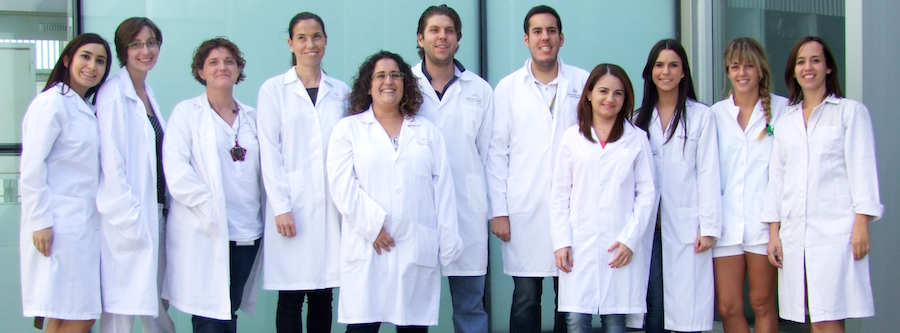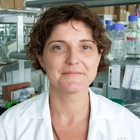Membrane Proteins Group

Main Researcher

Professor Ismael Mingarro
Education/Training
| Institution and Location | Degree (if applicable) | Year(s) | Field of Study |
|---|---|---|---|
| University of Valencia (Spain) | B.S. | June 1989 | Biology |
| University of Valencia (Spain) | Biochemistry Degree | April 1990 | Biochemistry |
| University of Valencia (Spain) | Ph.D. | September 1994 | Biochemistry |
| Torrey Pines Institute for Molecular Studies (San Diego) |
Post-doc | Oct-Dec 1994 | Combinatorial Chemistry |
| Stockholm University (Sweden) | Post-doc | 1995-1997 | Molecular Biology |
| Texas A & M University HSC (Texas) | Invited Professor | March-August 2009 | Cell and Molecular Biology |
Honors and Position
| Dates | Honors and Position |
|---|---|
| 01/1991-12/1994 | Predoctoral Fellow (Founded by the Spanish Ministry of Education). |
| 01/1995-07/1995 | Research Assistant Professor, Department of Biochemistry and Molecular Biology. University of Valencia. |
| 08/1995-07/1997 | Postdoctoral Researcher (Founded by EMBO). |
| 08/1997-12/1997 | Research Assistant Professor (Founded by the Swedish NFR), Department of Biochemistry and Biophysics. Stockholm University. |
| 01/1998-11/1999 | Researcher (Founded by the Spanish Ministry of Education), Department of Biochemistry and Molecular Biology. University of Valencia. |
| 12/1999–05/2011 | Associate Professor, Department of Biochemistry and Molecular Biology. University of Valencia. |
| 06/2011–Present | Full Professor, Department of Biochemistry and Molecular Biology. University of Valencia. |
Personal Statement
Since 2000 my lab has been devoted to the study of membrane proteins. Biological membranes provide unique environments for molecular function. Biomembranes also define the cellular architecture and provide the foundation for cellular identity. The study of biomembrane systems is a major focus in contemporary life science research with important implications for essentially all fields of basic and applied biomolecular science. Membrane proteins are involved in an impressive range of biological functions (e.g., signalling, energy transduction, small molecule and ion transport, cell motility, cell-cell interactions, nerve conduction) and are targets for a majority of the pharmaceutical drugs currently on the market.
About a quarter of cellular proteins are found embedded in lipid bilayers, where they perform critical functions. Yet, much of their structural and functional properties are still waiting to be unravelled.
My Group focuses on basic aspects of the folding and assembly of proteins in lipid membranes. Using simplified models we aim to understand how membrane proteins insert, fold and pack in biological membranes, and how they interact with themselves and with the bilayer lipids.
During this period I have advised eight PhDs and our research has been founded by five consecutive Grants from the Spanish system, as well as with several Grants from the Generalitat Valenciana.
Research Group
Staff
Ismael Mingarro (Head of the Group)
Manuel Sánchez
Concepción Abad
Post-Docs
Vicente Andreu (shared with Mar Orzáez group, CIPF)
Luis Martinez-Gil (Programa Juan de la Cierva)
PhD students
Carlos Baeza
Natalia Vera
Pre-Graduate Students
Sergi Beneyto
Guillermo Molla
Sara Micó
Technicians / Assistant Professor
Mª Jesús García-Murria
Grants and Research Projects
Project Title: Membrane protein Biology
Founded by: Ministerio de Economía y Competitividad (BFU2012-39482/BMC)
From: 01/01/2013
to: 31/12/2015
Principal Investigator: Ismael Mingarro
Number of researchers: 3
Total cost: 163.800 €
Project Title: Membrane protein expression, folding and dynamics
Founded by: Ministerio de Educación y Ciencia (BFU2009-08401/BMC)
From: 01/01/2010
to: 31/12/2012
Principal Investigator: Ismael Mingarro
Number of researchers: 3
Total cost: 205.700 €
Project Title: Membrane proteins insertion, assembly and topology
Founded by: Ministerio de Educación y Ciencia (BFU2006-08542/BMC)
From: 01/10/2006
to: 30/09/2009
Principal Investigator: Ismael Mingarro
Number of researchers: 5
Total cost:193.600 €
Project Title: Membrane protein insertion and assembly
Founded by: Ministerio de Educación y Ciencia (BMC2003-01532)
From: 01/12/03
to: 30/11/06
Principal Investigator: Ismael Mingarro
Number of researchers: 5
Total cost: 195.500 €
Project Title: Ayudas para grupos I+D+i
Founded by: Agència Valenciana de Ciencia i Tecnología (GRUPOS03/202)
From: 01/01/03
to: 31/12/05
Principal Investigator: Ismael Mingarro
Number of researchers: 10
Total cost: 59.167,30 €
Project Title: Folding and interactions in membrane proteins
Founded by:: Ministerio de Ciencia y Tecnología (BMC2000-1448)
From: 20/12/00
to: 20/12/03
Principal Investigator: Ismael Mingarro
Number of researcherss: 3
Total cost: 67.500 €
Selected recent publications
- Martinez-Gil L., Mingarro I.
Viroporins, Examples of the Two-Stage Membrane Protein Folding Model.
Viruses. 2015 Jun 26;7(7):3462-3482. - Whitley P., Mingarro I.
Stitching proteins into membranes, not sew simple.
Biol Chem. 2014 Dec;395(12):1417-24. doi: 10.1515/hsz-2014-0205. - Andreu-Fernandez V, Genoves A, Lee TH, Stellato M, Lucantoni F, Orzaez M, Mingarro I, Aguilar MI, Perez-Paya E.
Peptides Derived from the Transmembrane Domain of Bcl-2 Proteins as Potential Mitochondrial Priming Tools.
ACS Chem. Biol. (2014) 9(8):1799-811. - Peiro A, Martinez-Gil L, Tamborero S, Pallas V, Sanchez-Navarro JA, Mingarro I.
The Tobacco Mosaic Virus movement protein associates with but does not integrate into biological membranes.
J. Virol. (2014) 88(5):3016-26. - Martinez-Garay CA, Juanes MA, Igual JC, Mingarro I*, Bañó MC.
Transmembrane Serine of Rot1 protein is essential for yeast cell viability.
Biochem. J. (2014) 458(2):239-49.
* co-corresponding author - Bañó-Polo M, Martinez-Gil L, Wallner B, Nieva JL, Elofsson A & Mingarro I.
Charge pair interactions in transmembrane helices and turn propensity of the connecting sequence promote helical hairpin insertion.
J. Mol. Biol. (2013) 425(4):830-40. - Baeza-Delgado C., Marti-Renom M.A. & Mingarro I.
Structure-based statistical analysis of transmembrane helices.
Eur. Biophys. J. (2013) 42(2-3):199-207. - Bañó-Polo M, Baeza-Delgado C, Orzaez M, Marti-Renom MA, Abad C & Mingarro I.
Polar/Ionizable residues in transmembrane segments: effects on helix-helix packing.
PLoS ONE (2012) 7(9):e44263.
Contact Information

Departament de Bioquímica i Biologia Molecular
Universitat de València
C/ Dr. Moliner, 50
46100 - Burjassot (València)
Phone: +34 963543796
E-mail: Ismael.Mingarro@uv.es
Website: http://research.uv.es/membrana/
Peptide and Protein Chemistry Laboratory

Main Researcher

Professor Mar Orzáez Calatayud
Education/Training
| Institution and Location | Degree (if applicable) | Year(s) | Field of Study |
|---|---|---|---|
| University of Valencia (Spain) | Biology Degree | 1996 | Biology |
| University of Valencia (Spain) | Ph.D. | 2003 | Biology |
Honors and Position
| Dates | Honors and Position |
|---|---|
| 01/03/1997 | Associate Professor, Department of Biochemistry and Molecular Biology. University of Valencia. |
| 01/10/1997 | Predoctoral Fellow, Cytological Research Center. |
| 01/05/1998 | Associate Professor, Department of Biochemistry and Molecular Biology. University of Valencia. |
| 01/03/1999 | Predoctoral Fellow, Department of Biochemistry and Molecular Biology. University of Valencia. |
| 02/01/2004 | Postdoctoral Researcher, Cytological Research Center. |
| 01/01/2006 | Postdoctoral Researcher, Cytological Research Center. |
| 02/01/2007 | Postdoctoral Researcher I, Príncipe Felipe Research Center. |
| 02/01/2010 | Postdoctoral Researcher III, Príncipe Felipe Research Center. |
| 01/12/2010 | Associate Professor, Department of Biochemistry and Molecular Biology. University of Valencia. |
Research interest
- Apoptosis in medicine.
- Medicinal chemistry.
- Protein–protein interactions as a field of study and the use of diversity-oriented chemical libraries as source of modulators.
- Special focus in the development of new inhibitors of unwanted cell death and in the molecular mechanism of apoptosis.
New insights and developments to open translational opportunities.
Apoptosis (programmed cell death) is executed by strongly regulated pathways, and serve to remove infected, damaged or ectopic cells. The intrinsic pathway of apoptosis is initiated by many stresses inducing mitochondrial outer membrane permeabilisation (MOMP) mediated by proteins of the Bcl-2 family. Cytochrome c is then released into the cytosol and induces the formation of the apoptosome complex. Apoptosis dysregulation is at the root of a variety of diseases. While resistance has been linked to cancer and autoimmune diseases, excessive apoptosis is connected to neurodegeneration and ischemia-reperfusion damage. Apoptosis can be modulated through links with other cell signaling pathways. Then, apoptosis proteins can participate and cross-talk to non-apoptotic processes, such as cell differentiation and proliferation, mitochondrial morphogenesis, autophagy and inflammation.
Apoptosis susceptibility is co-determined by a multifactorial interplay but the molecular mechanisms and controls remain poorly understood. We aim to investigate how apoptosis is integrated, interrelated and modulated. To this end, we develop chemical tools to gain quantitative molecular information to understand physiological (light) and pathophysiological (dark) modes of apoptosis modulation. We believe that our approach will facilitate the knowledge-driven identification and development of targeted pharmacological interventions that modulate cell death susceptibility.
Research Group
Staff
Mar Orzáez Calatayud (Head of the Group)
PhD. Postdoctoral
Mónica Sancho.
Pre-Doctoral Researcher
Vicente Andreu Fernández.
Lab Technicians
Alicia García Jareño.
Scientific Collaborator
Cristina de La Torre Paredes.
Guillermo Garcia.
Alba García Fernández.
Grants as Projects Investigation
- BFU2015-70067-REDC
Iniciativa Española de Canales Iónicos.
Main researcher: Antonio Ferrer Montiel - SAF2014-52614-R
El interactoma de los dominios transmembrana de las proteinas bcl-2 como diana antitumoral.
Main researcher: Mar Orzáez - APM-09/15
Determinación de oncometabolitos mitocondriales responsables de resistencia en cáncer de endometrio.
Main researcher: Mar Orzáez - 690939. H2020-MSCA-RISE-2015
Exploiting Protein Complexes that Induce Cell-death. (EPIC)
Main researcher: Howard FearnHead
Selected publications
- de la Torre C, Mondragón L, Coll C, García-Fernández A, Sancenón F, Martínez-Máñez R, Amorós P, Pérez-Payá E, Orzáez M.
Caspase 3 Targeted Cargo Delivery in Apoptotic Cells Using Capped Mesoporous Silica Nanoparticles.
Chemistry. 2015 Oct 26;21(44):15506-10. doi: 10.1002/chem.201502413. Epub 2015. Sep 10. PubMed PMID: 26493876. - Marinho AD, Morais IC, Lima DB, Jorge AR, Jorge RJ, Menezes RR, Mello CP,Pereira GJ, Silveira JA, Toyama MH, Orzáez M, Martins AM, Monteiro HS.
Bothropoides auloensis venom effects on isolated perfused kidney and cultured renal tubular epithelial cells.
Toxicon. 2015 Sep 26;108:126-133. doi: 10.1016/j.toxicon.2015.09.031. [Epub ahead of print] PubMed PMID: 26410111. - Gortat A, Sancho M, Mondragón L, Messeguer À, Pérez-Payá E, Orzáez M.
Apaf1 inhibition promotes cell recovery from apoptosis.
Protein Cell. 2015 Nov;6(11):833-43. doi: 10.1007/s13238-015-0200-2. Epub 2015 Sep 11. PubMed PMID: 26361785; PubMed Central PMCID: PMC4624680. - Corredor M, Garrido M, Bujons J, Orzáez M, Pérez-Payá E, Alfonso I, Messeguer A.
Efficient Synthesis of Conformationally Restricted Apoptosis Inhibitors Bearing a Triazole Moiety.
Chemistry. 2015 Sep 28;21(40):14122-8. doi: 10.1002/chem.201502380. Epub 2015 Aug 13. PubMed PMID: 26270744. - Morais IC, Pereira GJ, Orzáez M, Jorge RJ, Bincoletto C, Toyama MH, Monteiro HS, Smaili SS, Pérez-Payá E, Martins AM.
L-Aminoacid Oxidase from Bothrops leucurus Venom Induces Nephrotoxicity via Apoptosis and Necrosis.
PLoS One. 2015 Jul 20;10(7):e0132569. doi: 10.1371/journal.pone.0132569. eCollection 2015.PubMed PMID: 26193352; PubMed Central PMCID: PMC4508040. - Santamaría B, Ucero AC, Benito-Martin A, Vicent MJ, Orzáez M, Celdrán A, Selgas R, Ruíz-Ortega M, Ortiz A.
Biocompatibility reduces inflammation-induced apoptosis in mesothelial cells exposed to peritoneal dialysis fluid.
Blood Purif. 2015;39(1-3):200-9. PubMed PMID: 25765663. - Orzáez M, Sancho M, Marchán S, Mondragón L, Montava R, Valero JG, Landeta O, Basañez G, Carbajo RJ, Pineda-Lucena A, Bujons J, Moure A, Messeguer A, Lagunas C, Herrero C, Pérez-Payá E.
Apaf-1 inhibitors protect from unwanted cell death in in vivo models of kidney ischemia and chemotherapy induced ototoxicity.
PLoS One. 2014 Oct 20;9(10):e110979. doi: 10.1371/journal.pone.0110979. eCollection 2014. PubMed PMID: 25330150; PubMed Central PMCID: PMC4203855. - de la Torre C, Mondragón L, Coll C, Sancenón F, Marcos MD, Martínez-Máñez R, Amorós P, Pérez-Payá E, Orzáez M.
Cathepsin-B induced controlled release from peptide-capped mesoporous silica nanoparticles.
Chemistry. 2014 Nov 17;20(47):15309-14. doi: 10.1002/chem.201404382. Epub 2014 Oct 10. PubMed PMID:25303093. - Andreu-Fernández V, Genoves A, Lee TH, Stellato M, Lucantoni F, Orzáez M, Mingarro I, Aguilar MI, Pérez-Payá E.
Peptides derived from the transmembrane domain of Bcl-2 proteins as potential mitochondrial priming tools.
ACS Chem Biol. 2014 Aug 15;9(8):1799-811. doi: 10.1021/cb5002679. Epub 2014 Jun 17. PubMed PMID:24905660. - Mondragón L, Mas N, Ferragud V, de la Torre C, Agostini A, Martínez-Máñez R, Sancenón F, Amorós P, Pérez-Payá E, Orzáez M.
Enzyme-responsive intracellular-controlled release using silica mesoporous nanoparticles capped with ε-poly-L-lysine.
Chemistry. 2014 Apr 25;20(18):5271-81. doi: 10.1002/chem.201400148. Epub 2014 Apr 2. PubMed PMID: 24700694. - Guevara T, Sancho M, Pérez-Payá E, Orzáez M.
Role of CDK5/cyclin complexes in ischemia-induced death and survival of renal tubular cells.
Cell Cycle. 2014;13(10):1617-26. doi: 10.4161/cc.28628. Epub 2014 Mar 25. PubMed PMID: 24675881; PubMed Central PMCID: PMC4050167. - de la Torre C, Agostini A, Mondragón L, Orzáez M, Sancenón F, Martínez-Máñez R, Marcos MD, Amorós P, Pérez-Payá E.
Temperature-controlled release by changes in the secondary structure of peptides anchored onto mesoporous silica supports.
Chem Commun (Camb). 2014 Mar 25;50(24):3184-6. doi: 10.1039/c3cc49421g. Epub 2014Feb 12. PubMed PMID: 24519805. - Sancho M, Gortat A, Herrera AE, Andreu-Fernández V, Ferraro E, Cecconi F,
Orzáez M, Pérez-Payá E.
Altered mitochondria morphology and cell metabolism in Apaf1-deficient cells.
PLoS One. 2014 Jan 9;9(1):e84666. doi: 10.1371/journal.pone.0084666. eCollection 2014. PubMed PMID: 24416260; PubMed Central PMCID: PMC3886985. - Sancho M, Herrera AE, Orzáez M, Pérez-Payá E.
Inactivation of Apaf1 reduces the formation of mutant huntingtin-dependent aggregates and cell death.
Neuroscience. 2014 Mar 14;262:83-91. doi: 10.1016/j.neuroscience.2013.12.062. Epub 2014 Jan 8. PubMed PMID: 24412373.
Contact Information

Centro de Investigación Príncipe Felipe
Peptide and Protein Chemistry Laboratory
Av. Autopista del Saler, 16
46012 Valencia
Phone. +34-963289681 Ext. 1301.
E-mail: morzaez@cipf.es
Website: http://www.cipf.es/web/portada/quimica-de-peptidos-y-proteinas